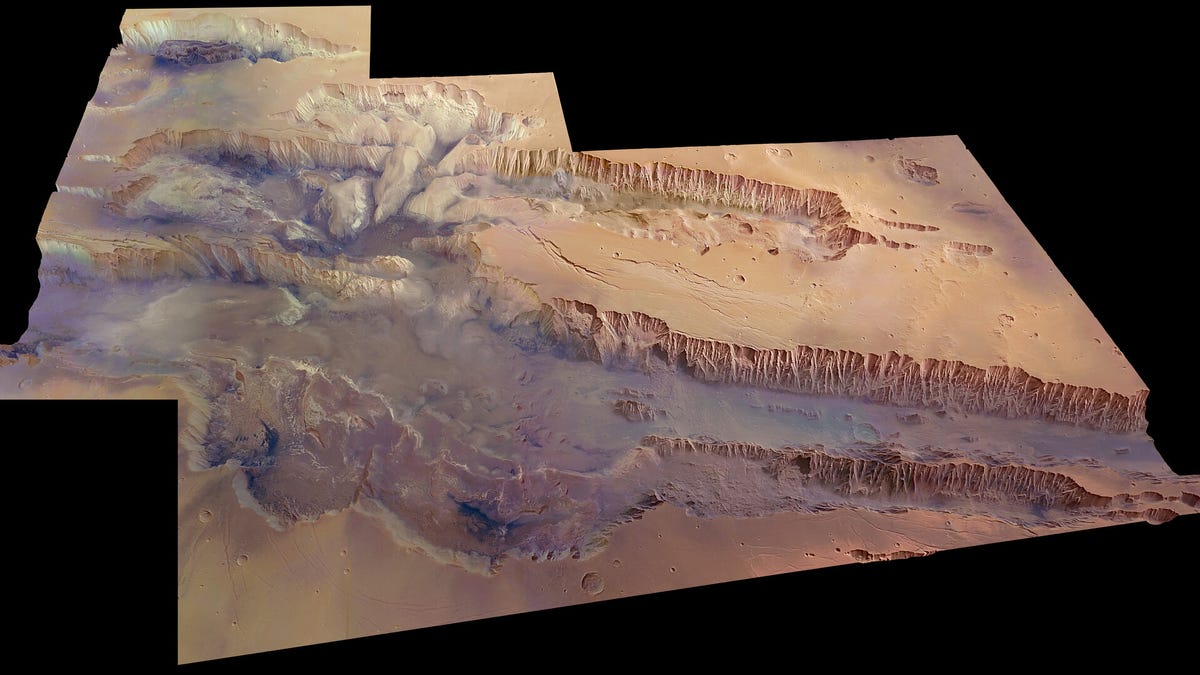Spacecraft discovers 'hidden water' in Mars Grand Canyon
The water is likely in the form of ice, and it could make the canyon system a tempting spot for human exploration.
Who's up for an adventure? You just need to catch a crewed spacecraft to Mars, land near a massive canyon there and go in search of hidden water. The ExoMars Trace Gas Orbiter (TGO) spacecraft has found evidence of "significant amounts of water" in the Valles Marineris canyon system on the red planet.
TGO is operated by the European Space Agency and Russian space agency Roscosmos. The orbiter has an instrument on board that maps hydrogen in the upper layer of Martian soil. Data shows an unusual amount of hydrogen in Candor Chaos, a central region of Valles Marineris, indicating that as much as 40% of the near-surface material in that area could be water.
"With TGO we can look down to one meter below this dusty layer and see what's really going on below Mars' surface -- and, crucially, locate water-rich 'oases' that couldn't be detected with previous instruments," Igor Mitrofanov of the Space Research Institute of the Russian Academy of Sciences said in an ESA statement on Wednesday. Mitrofanov is lead author of a study on the water findings published in the journal Icarus.
Valles Marineris is so massive, NASA has called it "the Grand Canyon of Mars." Except it's much, much bigger than the US landmark. The Mars version stretches over 1,860 miles (3,000 kilometers) in length and reaches down as far as 5 miles (8 kilometers).
The water found in Valles Marineris might be tied up with minerals, but the researchers say it's more likely to be in the form of ice. That leads to questions about how the water ice is preserved in an area of Mars where it would be expected to evaporate. "This suggests that some special, as-yet-unclear mix of conditions must be present in Valles Marineris to preserve the water -- or that it is somehow being replenished," ESA said.
Scientists have been working to tease out both the history and the present existence of water on Mars, investigating what might be hidden lakes (or might just be frozen clay) and mapping out water ice that could be accessed by future human explorers. Locating and exploiting local water resources would be key to any ambitions of colonizing Mars.
"Knowing more about how and where water exists on present-day Mars is essential to understand what happened to Mars' once-abundant water, and helps our search for habitable environments, possible signs of past life, and organic materials from Mars' earliest days," said ExoMars Trace Gas Orbiter project scientist Colin Wilson.
According to NASA, Valles Marineris is the largest known canyon in the solar system and it would stretch from New York to California if it were located on Earth. If space tourism ever reaches the red planet, the canyon system would be a sightseeing delight. Throw an abundance of water into the equation, and we might be looking at humanity's future home away from home on Mars.


